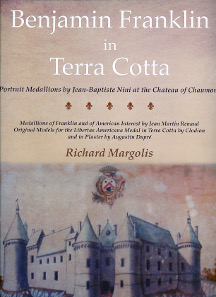by Ursula Kampmann
translated by Annika Backe
June 11, 2015 – Some people can tell many a story about the coins and medals they are selling. One of those people is Richard Margolis. Visiting his table during a coin fair in a quieter moment, sitting down to listen to him is always an asset. He becomes particularly eloquent when his own collecting field is touched upon: medals manufactured between 1763 and 1788. And it gets even more interesting when he starts to talk about his research on the terra cotta portraits of Italian artist Jean-Baptiste Nini. Now, Richard Margolis has put down his profound knowledge in a book that exclusively deals with the terra cotta portraits of Benjamin Franklin created by Jean-Baptiste Nini.
Richard Margolis, Benjamin Franklin in Terra Cotta. Kolbe & Fanning, Gahanna (OH), 2015. 232 pages, illustrated in color. 26 x 33.8 cm. Hardcover. ISBN: 978-0-934352-12-3. US$ 195.
Kolbe & Fanning are the publishers of this monograph. As befits booksellers specialized in rare numismatic literature, their firm presents a book that is a treat to every book lover thanks to its elegant design, to begin with: cloth, title in gilt letters on spine, attractively designed jacket, fine paper with a type area that leaves the page room to breathe, superb illustrations and an unostentatious layout. Indeed, this book should be recommended to all publishers of numismatic literature, as an illustration of how beautiful numismatic books can be.
The content matches the layout. In a concise style, Richard Margolis talks about the context within which these marvelous pieces were created. Responsible was the business-minded owner of the Château de Chaumont, Jacques-Donatien Le Ray, who was not only strongly sympathetic to the American cause for independence. He also owned a glassmaking and earthenware factory overseen by the artist Jean-Baptiste Nini. These are the main characters. Le Ray commissioned Jean-Baptiste Nini with the creation of several portraits of Franklin for the terra cotta medallions, which were cheap and easy to reproduce, his factory was producing.
He was not so much interesting in making great profit but rather wanted to promote the American cause. It was important to spotlight Benjamin Franklin, the man who wanted the French to support the United States in their fight for independence from Great Britain. After all, the buyers of those medallions, the nobility and wealthy citizens, were the ones who had political influence.
From this emerged the marvelous brick red medallions which have been studied by Richard Margolis with such great devotion as only a man can show who has dealt with this matter for decades. Naturally, he reaches some interesting conclusions. He distinguishes the contemporary medallions, made in the Chaumont factory, from aftercasts made in later times. Meticulously, he lists the different types and known casting molds. His profound knowledge is incorporated here, and one can virtually see the author turning the medallion in his hand and pointing their characteristics to the audience.
Comprehensive appendices conclude the book. There, the author focuses on interesting side issues, as the important collectors who possessed Nini medallions, or the marks on the reverse of some medallions, indicative of attempts to produce aftercasts.
Two further articles on terra cotta medallions make the very last part of the book, one dealing with the Benjamin Franklin medallions created by Jean Martin Renaud, the other one focusing on the model for the Libertas Americana Medal.
This book review can easily be summarized: Anybody fond of beautiful things will love this book.




